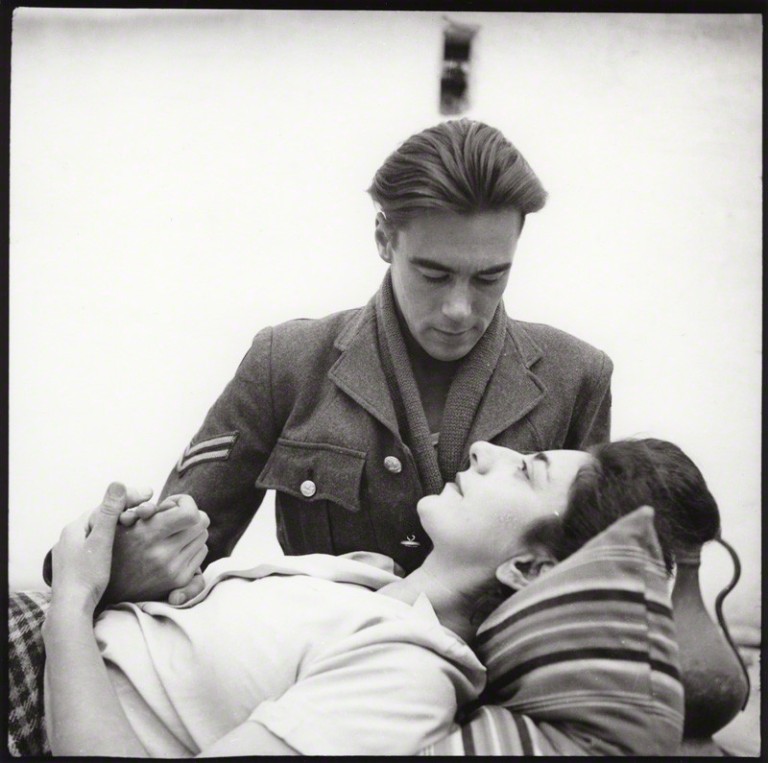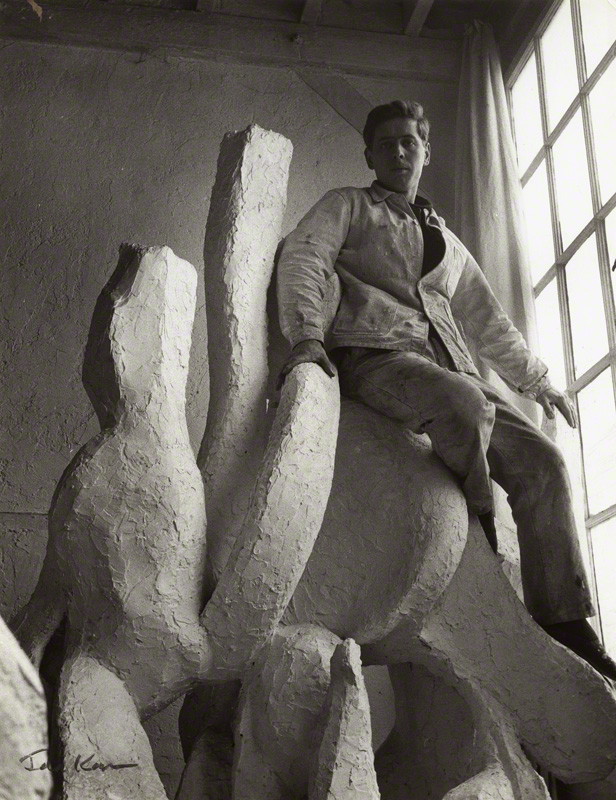 April 8: The artist in their studio poses a challenge for the photographer.
April 8: The artist in their studio poses a challenge for the photographer.
Two photographers of artists were born on this date; Vilhelm Tillge in 1843 in Copenhagen, Denmark (†1896, Copenhagen) and Ida Kar in 1908 in Tambov, Russia (†1974, London).
Frederik Wilhelm Tillge (who signed his works Vilhelm Tillge) was a Danish portrait photographer who started as a photographer in Elsinore before setting up shop at Købmagergade 38 in Copenhagen.

Numbers of his urban landscapes also survive, over 100 of them being stereo views, one most famously one showing his studio in Købmagergade about 1863 and another being the oldest known photo of Raadvad from about 1866.


He portrayed contemporary artists in their studios and also made reproductions of paintings that he sold for 1 Mark apiece. From years 1878 to 1884 he was the photographer contracted to document the Charlottenborg Spring Exhibition.
Tillge’s negatives went to Christian Neuhaus (1833-1907) and from him to his pupil, Oluf W. Jørgensen (1853-1922) both of whom continued printing and selling them.
His artists’ portraits are the product of a large camera set on a tripod that he has transported to their studios. Here, Otto Diderich Ottesen, a Danish painter of flowers, is posed, brush and mahlstick in hand, in front of one of his larger works (shown right). This arrangement is of course a cliché in portrait treatments of artists, and Dornac handles his slightly later series on French artists in Paris in the same way, but the care with which Tillge sets up his portrait is clear; three of this artist’s works, large and small, are arranged to fill the frame, and a dead corner of the frame is filled with a potted succulent.
Similarly, the portly Carl Henrik Bøgh stands on an animal skin rug before one of his rather improbable landscapes (left) which sits unfinished on his easel.
Tillge takes pains in this portrait to echo, against a larger work that forms the background, the arches of Johan Peter Kornbeck’s A Cloister, Lake Garda, painted nearly twenty years before this photograph was made, and which is in its frame.
Unfortunately these small JPGs are the only copies of photographs Tillge that can be found on the net, but they serve to show the changes in artists’ portraits that come with the availability of more portable cameras.
That Ida Kar was the first photographer in Britain to be honoured, in 1960, with a major retrospective is indication of the regard with which she was once held, though sadly hers is a name rarely heard these days.

Born to Armenian parents in Tambov, 460km south east of Moscow, Kar shortened her name from Karamian. In Paris she encountered Heinrich Heidersberger, a young German surrealist painter, who was later a photographer famous in the fifties for his rhythmogramm light paintings. She embraced Surrealism and she and Heidersberger first experimented with photography then. In 1933, working as a photographer’s assistant she met and married Edmond Belali with whom she named their ‘Idabel’ photography studio in Cairo, and in which they exhibited in the city’s surrealists in 1943 and 1944, but they divorced during the war. Through these Surrealist connections she met Victor Musgrave, an encounter which changed her direction in life; she married him in 1944, and the couple moved to London the next year.

She found work as a theatrical photographer, and from 1949 worked from their studio and gallery at 1 Litchfield Street, Charing Cross in the theatre district and near Soho.
In the early 50s Jacob Epstein commissioned a portrait from her and from that point she turned her attention to artists of London, Paris and St. Ives as subjects. In Epstein’s case she follows the same formula as Tillge, posing the sculptor in front of his towering artwork.

This was an era, just after the war, in which British artists found themselves in situations very different from those of the comfortable bourgeoise painters and sculptors in Tillge’s Copenhagen. Rationing was still in place and since the Blitz there was a dire housing shortage in London; accommodation was hardly salubrious, and commissions few. However a bohemian culture thrived around Soho which was a support network for the artists. It was a world not unlike that of Gulley Jimson in the 1930s.
It is a period I remember fondly from three years of my childhood in London in the more genteel but just as artistic Kilburn and West Hampstead, where my parents’ entertainment was to invite around to tea of for drinks the colourful, eccentric people my father would meet in his work as a journalist. The turn-of-century flat we lived in was heated only when there were sufficient coins for the meter and the plaster was still crumbly after bomb impacts down the street during the war.
In the spring of 1954, Kar took a three-month sabbatical from her theatrical photography to build up a notable portfolio of artists at work and Musgrave took over their whole building to house his Gallery One. There Kar’s first solo was Forty Artists from London and Paris, the results of her visits to studios and ateliers in Paris and fifteen of her portraits of British artists in October. The pictures and a book of the same title were licensed to Camera Press and captioned by Bill Hopkins, a novelist and lodger at Litchfield Street.

Gallery One was well placed to become a meeting place for London’s avant garde artists as it was only five minutes walk from the infamous Colony Club at 41 Dean Street, watering hole of Augustus John, Henrietta Moraes, Francis Bacon, Nina Hamnette, Lucian Freud and another photographer of the artists of this bohemia, John Deakin.

Kar improvises on the idea of the artist posing with their artwork in portraits such as this one of Stanislas Lelio in which he perches, not too comfortably, on his abstract sculpture in his Paris studio.
One of her talents is to recognise the similarities between artists and their works. Henry Moore squints into the sunlight coming from an open doorway. His features are flattened and as a result his head reads like those of the sculptures around him with hollows for eyes abbreviated, rounded craniums.

Germaine Richier is made to seem to interact with what appears to be a self-portrait as Kar catches her mid-conversation.

In the case of Stanley Spencer, his trademark umbrella, round celluloid-rimmed glasses and battered, paint-bespotted suit and vest, suffice to characterise the iconic, eccentric British religious painter.

With the Whitechapel Art Gallery retrospective March 1960 behind her, Kar began the decade as ‘photographer to the famous’. Rising star Op artist Bridget Riley is made to appear immersed by her painting at her second solo exhibition at Gallery One. Kar’s proof sheet reveals the extent of her direction of her sitter; Kar’s charm, strength of personality and self-assertion is clearly a major asset to the photographer.

In 1968 John Couzins (his photo of Kar that year, left) became one of Kar’s last assistants and together they portrayed fellow-photographer Bill Brandt in his Kensington flat. These, made when Kar was sixty and Brandt four years older, return to her interest in surrealism.
They are strange photographs, and daring, considering the legendary status and quality of Brandt’s own portraiture of the 1960s. The figure concealed behind Brandt, possibly his second wife Marjorie who was the inspiration for his several series of nudes, inserts two of Brandt’s wide-angle seaside nudes (hands only in this case) one after the other into the shots and consequently her own hands appear too (though if she was the model on the beach, it seems difficult to confirm it). Brandt remains deadpan, playing along with an odd exercise in chiromancy that he would have been unlikely to undertake himself.


The result is that Ida Kar, in a reprise of her own 1940 surrealist image of a plaster cast of hands, determines to entangle Brandt in his own work in what is both homage and also, is it a bit of thunder stealing?
The National Portrait Gallery showed Ida Kar: Bohemian Photographer, 1908-74 10 March – 19 June 2011 and holds 1530 of Ida Kar’s portraits, the majority of which are of artists. They are well worth a browse.










One thought on “April 8: Artists”